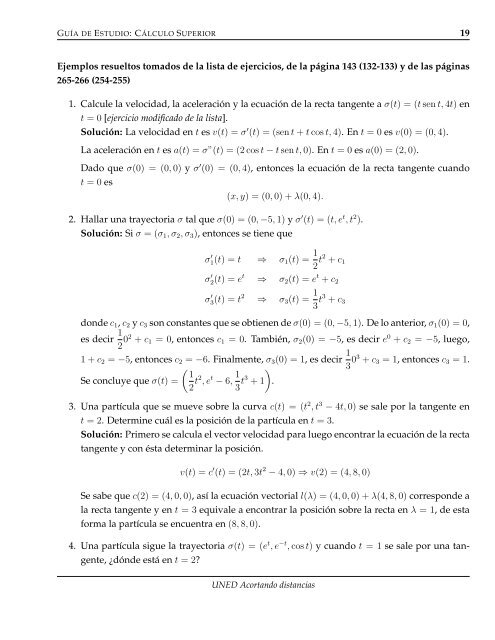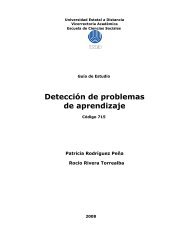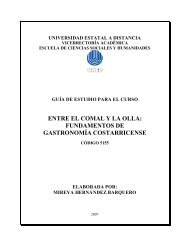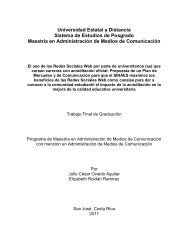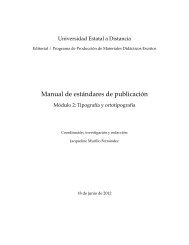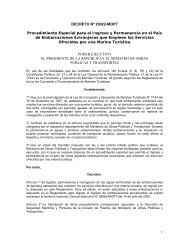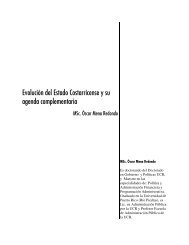GE3011 Cálculo Superior - Repositorio de la Universidad Estatal a ...
GE3011 Cálculo Superior - Repositorio de la Universidad Estatal a ...
GE3011 Cálculo Superior - Repositorio de la Universidad Estatal a ...
You also want an ePaper? Increase the reach of your titles
YUMPU automatically turns print PDFs into web optimized ePapers that Google loves.
GUÍA DE ESTUDIO: CÁLCULO SUPERIOR 19<br />
Ejemplos resueltos tomados <strong>de</strong> <strong>la</strong> lista <strong>de</strong> ejercicios, <strong>de</strong> <strong>la</strong> página 143 (132-133) y <strong>de</strong> <strong>la</strong>s páginas<br />
265-266 (254-255)<br />
1. Calcule <strong>la</strong> velocidad, <strong>la</strong> aceleración y <strong>la</strong> ecuación <strong>de</strong> <strong>la</strong> recta tangente a σ(t) = (t sen t, 4t) en<br />
t = 0 [ejercicio modificado <strong>de</strong> <strong>la</strong> lista].<br />
Solución: La velocidad en t es v(t) = σ ′ (t) = (sen t + t cos t, 4). En t = 0 es v(0) = (0, 4).<br />
La aceleración en t es a(t) = σ”(t) = (2 cos t − t sen t, 0). En t = 0 es a(0) = (2, 0).<br />
Dado que σ(0) = (0, 0) y σ ′ (0) = (0, 4), entonces <strong>la</strong> ecuación <strong>de</strong> <strong>la</strong> recta tangente cuando<br />
t = 0 es<br />
(x, y) = (0, 0) + λ(0, 4).<br />
2. Hal<strong>la</strong>r una trayectoria σ tal que σ(0) = (0, −5, 1) y σ ′ (t) = (t, e t , t 2 ).<br />
Solución: Si σ = (σ1, σ2, σ3), entonces se tiene que<br />
σ ′ 1(t) = t ⇒ σ1(t) = 1<br />
2 t2 + c1<br />
σ ′ 2(t) = e t ⇒ σ2(t) = e t + c2<br />
σ ′ 3(t) = t 2 ⇒ σ3(t) = 1<br />
3 t3 + c3<br />
don<strong>de</strong> c1, c2 y c3 son constantes que se obtienen <strong>de</strong> σ(0) = (0, −5, 1). De lo anterior, σ1(0) = 0,<br />
es <strong>de</strong>cir 1<br />
2 02 + c1 = 0, entonces c1 = 0. También, σ2(0) = −5, es <strong>de</strong>cir e0 + c2 = −5, luego,<br />
1 + c2 = −5, entonces c2 = −6. Finalmente, σ3(0) = 1, es <strong>de</strong>cir 1<br />
3 03 + c3 = 1, entonces c3 = 1.<br />
<br />
1<br />
Se concluye que σ(t) =<br />
2 t2 , e t − 6, 1<br />
3 t3 <br />
+ 1 .<br />
3. Una partícu<strong>la</strong> que se mueve sobre <strong>la</strong> curva c(t) = (t 2 , t 3 − 4t, 0) se sale por <strong>la</strong> tangente en<br />
t = 2. Determine cuál es <strong>la</strong> posición <strong>de</strong> <strong>la</strong> partícu<strong>la</strong> en t = 3.<br />
Solución: Primero se calcu<strong>la</strong> el vector velocidad para luego encontrar <strong>la</strong> ecuación <strong>de</strong> <strong>la</strong> recta<br />
tangente y con ésta <strong>de</strong>terminar <strong>la</strong> posición.<br />
v(t) = c ′ (t) = (2t, 3t 2 − 4, 0) ⇒ v(2) = (4, 8, 0)<br />
Se sabe que c(2) = (4, 0, 0), así <strong>la</strong> ecuación vectorial l(λ) = (4, 0, 0) + λ(4, 8, 0) correspon<strong>de</strong> a<br />
<strong>la</strong> recta tangente y en t = 3 equivale a encontrar <strong>la</strong> posición sobre <strong>la</strong> recta en λ = 1, <strong>de</strong> esta<br />
forma <strong>la</strong> partícu<strong>la</strong> se encuentra en (8, 8, 0).<br />
4. Una partícu<strong>la</strong> sigue <strong>la</strong> trayectoria σ(t) = (e t , e −t , cos t) y cuando t = 1 se sale por una tan-<br />
gente, ¿dón<strong>de</strong> está en t = 2?<br />
UNED Acortando distancias


